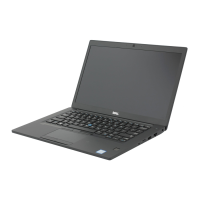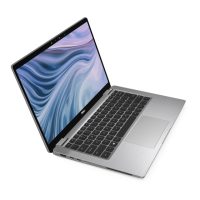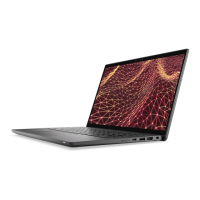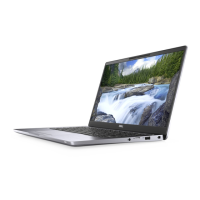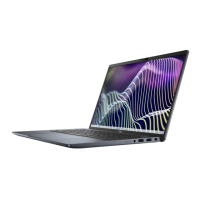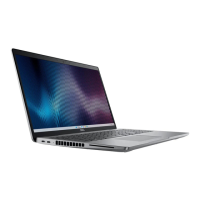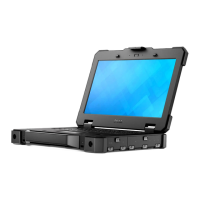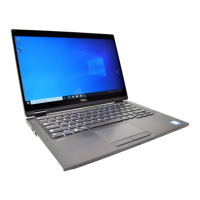How to resolve EC unable to program i-Fuse on Dell Laptop?
- BbrockdanielSep 13, 2025
If the EC is unable to program i-Fuse on your Dell Laptop, replace the system board.

How to resolve EC unable to program i-Fuse on Dell Laptop?
If the EC is unable to program i-Fuse on your Dell Laptop, replace the system board.
| Processor | 8th Generation Intel Core i5/i7 |
|---|---|
| Graphics | Intel UHD Graphics 620 |
| Operating System | Windows 10 Pro |
| Display | 14-inch FHD (1920 x 1080) |
| RAM | 4GB, 8GB, 16GB, 32GB DDR4 |
| Storage | 256GB/512GB SSD |
| Battery | 4-cell 60Whr or 3-cell 42Whr |
| Ports | 2 x USB 3.1, 1 x USB-C, HDMI, RJ-45, headphone/microphone combo jack |
| Wireless | Intel Dual Band Wireless-AC 8265 Wi-Fi + Bluetooth 4.2 |
Essential safety guidelines for handling the computer and preventing ESD damage.
Measures to prevent damage from static electricity and use of ESD field service kits.
Proper procedures for handling and transporting static-sensitive computer components.
Steps to take before opening or servicing the computer, including power and cable disconnection.
Steps to take after servicing the computer, including reconnecting devices and power.
List of tools required for component removal and installation procedures.
Details on the different screw sizes used throughout the system for component assembly.
Procedures for removing and installing the SIM card and SIM card tray.
Instructions for removing and installing the computer's base cover for access.
Precautions and steps for removing and installing the lithium-ion battery.
Procedures for removing and installing the Solid State Drive (SSD).
Steps for removing and installing the speaker module.
Procedure for removing and installing the coin cell battery.
Steps for removing and installing the Wireless Wide Area Network (WWAN) card.
Steps for removing and installing the Wireless Local Area Network (WLAN) card.
Procedures for removing and installing memory modules (RAM).
Steps for removing and installing the heat sink assembly including the fan.
Procedures for removing and installing the LED board.
Steps for removing and installing the smart card cage.
Procedures for removing and installing the touchpad buttons board.
Steps for removing and installing the power connector port.
Procedures for removing and installing the entire display assembly.
Steps for removing and installing the touch display panel.
Procedures for removing and installing the display bezel.
Steps for removing and installing the nontouch display panel.
Procedures for removing and installing the camera microphone module.
Procedure for removing and installing the display hinge caps.
Procedures for removing and installing the system board.
Procedures for removing and installing the keyboard assembly.
Procedure for replacing the palm rest assembly.
Details on DDR4 memory technology, specifications, and differences from DDR3.
Explanation of the HDMI 1.4 interface and its features like Ethernet and 3D support.
Overview of Universal Serial Bus evolution, speeds, and applications.
Information on the USB Type-C connector, its capabilities, and power delivery.
Explanation of Thunderbolt 3 technology utilizing the USB Type-C connector.
Detailed hardware specifications of the computer, including processor, memory, and display.
List of function key combinations and their corresponding actions on the Latitude 7490.
Explanation of the BIOS role in managing system data flow and hardware.
Steps to access the BIOS setup utility by pressing F2 during system startup.
Description of keys used to navigate and interact within the BIOS setup menus.
Instructions to access the one-time boot menu via F12 for device selection.
Overview of various configuration options available in the system setup.
Details on primary hardware features, system information, and device configuration.
Options for configuring integrated network, SATA, and other system devices.
Settings related to display brightness and video configuration.
Options for setting administrator and system passwords, and security configurations.
Configuration options for the Secure Boot feature and key management.
Settings for Intel SGX for running code and storing sensitive information securely.
Options to enable/disable multi-core support and Intel SpeedStep for performance.
Settings for managing AC behavior, Intel Speed Shift, and USB wake support.
Configuration of system startup behavior, including adapter warnings and fast boot.
Options related to system manageability features like USB provision.
Settings for utilizing virtual machine monitor capabilities and Intel virtualization.
Configuration options for wireless devices like WLAN, WWAN, and Bluetooth.
Options for system maintenance, including Service Tag, BIOS downgrade, and data wipe.
Options to view and clear BIOS events, thermal events, and power events.
Instructions for creating and managing system and administrator passwords.
Instructions for updating the system BIOS via Windows or a USB drive.
Creating and managing system and setup passwords for computer security.
Procedure to reset BIOS settings by clearing CMOS and removing the coin-cell battery.
Guidance on clearing BIOS and system passwords by contacting Dell technical support.
List of operating systems supported by the system, including Windows and Ubuntu.
Steps to download and install drivers from the Dell support website for Windows.
Verification of Intel chipset and management engine interface drivers installation.
Verification of the video driver installation status.
Verification of the audio driver installation status.
Verification of network adapter and WiFi driver installation status.
Verification of USB controller and connector driver installation status.
Verification of storage controller and disk drive driver installation status.
Verification of drivers for other system components like security and HID devices.
Precautions and procedures for handling swollen lithium-ion batteries safely.
Overview of the ePSA diagnostic tool for system hardware assessment.
Information on M-BIST and L-BIST built-in self-tests for diagnosing system board issues.
Procedure for testing the LCD power rail and identifying potential connection issues.
Steps to run the built-in self-test for the LCD screen to check for abnormalities.
Explanation of diagnostic LED blinking patterns and their corresponding problem descriptions.
Steps to recover the operating system using Dell SupportAssist OS Recovery.
Procedure to reset the Real Time Clock (RTC) to resolve No POST/No Boot situations.
Recommendations for creating backup and recovery media for Windows.
Procedure for power cycling WiFi components to resolve connectivity issues.
Steps to drain residual static electricity and perform a hard reset.
Available resources for getting product information, support, and troubleshooting help.
Methods for contacting Dell for sales, technical support, or customer service issues.
